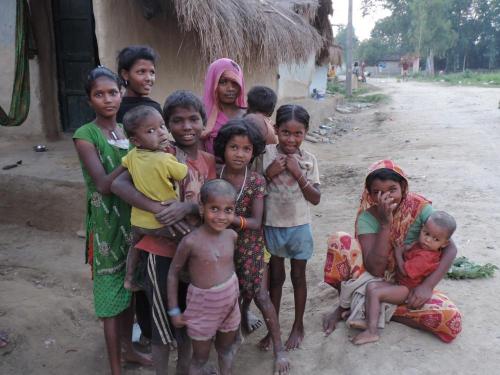
Karjanha, Siraha where I've lived for the past 5.5 months is considered to be a village. When I think of the word "village" I think of people living without electricity, few if any roads, basic necessities lacking.
Recently I stayed with a friend in Kathmandu, the largest, developed city in Nepal. However the friend and her family live on the outskirts up in the hills. To get to her home one had to go over a number of so-called roads, walk up mud steps, you get the picture. Prior to visiting my friend she told me that she lived in a village in Kathmandu. I scoffed at this thinking a village in Kathmandu? I live in a village, how could anyone in Kathmandu live in a village?
In fact my friend's home seems to be in more of a village than where I'm living. My friend has electricity, cooking gas, toilet connected to the house (something which only 14% of the households in Karjanha have) but somehow given the somewhat "remote" location this seems more like a village then where I'm living. In Karjanha we are connected to the main road through a fully paved road, although there are many non-paved roads which motorcycles, bicycles and the few cars use. Looking at the lights in the Kathmandu Valley from my friend's home one can see that there is a great deal of electricity, unlike Karjanha; when the lights go out, they are out.
A village though is not what one might think. Maybe I haven't seen really remote villages, where there is no electricity, where people live in huts, there are no roads, no schools. It's really difficult to say.
I recently read an article in the Himalayan Times which discussed how marketers (corporates) should provide more focus on rural Nepal, where there seem to be changes based on money invested from people's families who have a relative living overseas. The article seemed to imply that villages are changing based on this new found money and that marketers need to pay more attention. I'm not so sure about change.
Karjanha is a nice enough place but there still seems to be a lot of "poverty". People do seem to get enough food and have a place to sleep; in this case by poverty I'm referring to a dearth of schools where children learn how to think critically enabling an increase in literacy; a lack of livelihood opportunities; access to clean drinking water and toilets, an area in which women do not have to spend their entire day hunting down wood for cooking, etc.
A village then becomes less of a place where there is little; this is more about community. It's not in any sense some kind of romanticized, "oh, isn't this cute". Villages are where people live, raise their families, enjoy and despair about life; the same as neighborhoods in the US. Villages may look different than a neighborhood with paved roads, houses nice and neatly ordered, street lights, trees, grass, but they are the same. A village might have more dirt, children may not be wearing shoes, their clothes dirty and torn, I might have to use an outhouse, there might not be hot water, but never-the-less, it's home for many, including me.
This all comes down to relationships, flexibility, commitment to wanting to helping the world to become kinder and to enable greater understanding. Often I find that what I've experienced in growing up in the US, isn't necessarily best for others, although they might think so, i.e. the number of Nepalis that regularly tell me that they want to go to the US. Often times people will say to me, "but you can't make this America"; my response is that I'm not trying to make things like America.
A village/neighborhood and its definition comes down to how people relate to one another. This isn't about what we perceive but is more about what exists.










Add new comment